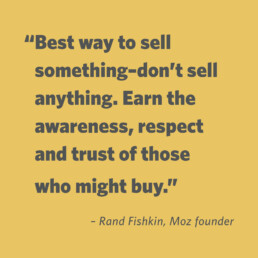
What is content marketing?
The purpose of content marketing is to provide valuable, free content to your target audience to improve their lives and/or simplify their jobs. Instead of focusing on a product or service, content marketers examine common consumer pain points and passions and offers relevant advice or entertainment to targeted personae through select media.
The idea is to attract, acquire and engage in a way that genuinely interests a target audience in order to move them to the next level of the sales funnel. Content marketing can forge initial connections by demonstrating similar interests and values. Additionally, it can demonstrate industry thought leadership, building a level of trust and authority that usually comes from a protracted sales cycle. And all of this can take place before you actually speak to the prospective client.
Why content marketing?
Think about it like this: not everyone is interested in learning about a blender right now, but most people are curious to see what the Blendtec blender can do to an iPhone in the popular “Will it Blend?” YouTube series. The takeaway is a dramatic demonstration of the Blendtec blender’s power in a package that sends my inner 13-year old reeling and ready to share.
The growing power of the consumer
Consumers have more control over the buyer’s journey than ever before, often moving themselves through the various stages of awareness, research, consideration and decision before a salesperson speaks with them directly, in both B2B and B2C environments. They are collecting information and forming opinions, with or without your help.
Essentially, content marketing is marketing communication enacted to address the ways that the modern consumer proactively seeks and consumes information. Put enough breadcrumbs out there and someone is bound to consume their way back to you, or at least discover that you understand how their industry’s bread is made. The fact that the content is unique, entertaining, free and comes with no strings attached makes it near irresistible.
“Best way to sell something – don’t sell anything. Earn the awareness, respect and trust of those who might buy.” – Rand Fishkin, Moz founder
What’s old is new again
Disciples and detractors alike are quick to point out that content marketing isn’t new. In 1732, Benjamin Franklin began publishing Poor Richard’s Almanack, an entertaining collection of weather reports, puzzles and household tips, to promote his printing business. In 1904, the Jell-O Company distributed free copies of the Jell-O Recipe Book, to dramatically boost product awareness and sales. Still others say that, given the hyper-advanced and rapid-fire state of modern mass media, citing these examples doesn’t make sense.
Marketing and branding expert Mark Ritson feels that content marketing is an unnecessary rebranding of basic tactics marketers were already using, and that all the definitions of content marketing “seem to describe marketing communications” and often place too great an emphasis on creating content for the sake of content.
You can read his article here.
Digital media and the marketing landscape
Content marketing, as a distinct and packaged discipline, was essentially created to engage the self-publishing aspect of marketing that became so powerful as digital media began to take hold. Marketers began to think like publishers and messaging – in order to pique and retain reader interest – evolved to focus on the audience rather than the product. Instead of direct promotion, content marketers sought to indirectly engage consumer interest.
At its core, content marketing requires a deep understanding of the customer and how their information needs to evolve along the buyer’s journey, and a proactive approach to answering their most important questions.
However, if a content writer or manager is instructed to “create content” without an understanding of the overall acquisition and nurturing strategy, of course you’ll end up with countless articles on Pokémon Go and ever-increasing desperation in numbered lists of How to Love Millenials that will likely do more to damage your brand than attract consumer action.
When to use content marketing
Content marketing begins and excels at the awareness stage, but it doesn’t end there. To understand, check out my definitions:
- Content is any archivable communication delivered to a target audience.
- Content marketing is the strategic creation of communication to meet a marketing goal.
Some people think that marketing is for the promotion of the company and product, relegating content marketing to lead attraction and top-of-funnel nurturing, but that’s really only part of the equation. As I mentioned before, the purpose of content marketing is to provide valuable, free content to your target audience to improve their lives and/or make it easier for them to do their jobs – that doesn’t mean that your message can’t eventually evolve to include product when the time is right, or that content marketing couldn’t give way to another nurturing strategy.
Sound content strategy is based on market research and great content marketing works in service of overall marketing goals. Different messages can be created for different personae identified in the market research phase, and those messages will change as the audience moves through the sales funnel.
So, in some instances, content marketing is used to create awareness, in others it is used to nurture leads and even close sales. It is vital to remember that the strategy of content marketing considers the entire progressive message and allows an uninterrupted consumer path to purchase.
Content marketing, to Mark Ritson’s point, does entail existing aspects of marketing, which may lead to confusion in how best to use it and at what point it should be implemented. But, I think that the package could be worth more than the sum of its parts, provided the overall marketing strategy isn’t lost in the shuffle.
So, it turns out the new danger of content marketing is actually an old pitfall of marketing in general: being too clever for your own good and allowing function follow form.